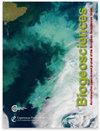罗德环流(地中海东部)中上层生态系统和有机碳收支的季节和年际变化:冬季混合的影响
IF 3.9
2区 地球科学
Q1 ECOLOGY
引用次数: 0
摘要
摘要罗德环流是地中海东部黎凡特盆地环流的一个持续气旋特征。虽然它位于地中海最贫营养的盆地,但由于与黎凡特中间水形成相关的强烈冬季营养供应,它是一个相对较高的初级生产区。在这项研究中,使用三维耦合水动力-生物地球化学模型(SYMPHONIE/Eco3M-S)来表征罗德环流生态系统的季节和年际变化,并估计2013-2020年期间的年度有机碳预算。将模型输出与卫星数据以及从游轮和生物地球化学- argo浮标收集的原位数据进行比较,发现该模型能够重建黎凡特盆地的主要季节和空间生物地球化学动力学。模型结果表明,在冬季混合期,浮游植物首先在养分供应的维持下逐步生长。然后,由热损失和风事件驱动的短时间对流有利于养分注入、有机碳输出和对初级生产的光限制,与浮游植物生长的短时间交替。年有机碳收支估算表明,罗德斯环流为自养区,上层(0 ~ 150 m)净群落产量为31.2±6.9 gcm -2 -1。上层的净群落产量在7年期间几乎通过物理转移达到平衡,(1)通过向下出口(16.8±6.2 gcm - 2year -1)和(2)通过向周围地区的横向运输(14.1±2.1 gcm - 2year -1)。中间层(150-400 m)似乎也是周围黎凡特海(7.5±2.8 gcm - 2year -1)有机碳的来源,主要是通过冬季混合后黎凡特中间水的俯冲作用。罗兹环流年际变动性高,在热损失大、混合层深的年份,初级生产量、净群落生产量和出口量增加。然而,年度初级产量似乎只是部分由冬季垂直混合驱动。根据我们的结果,我们可以推测未来温度和分层的增加可能会强烈影响该地区的碳通量。本文章由计算机程序翻译,如有差异,请以英文原文为准。
Seasonal and interannual variability of the pelagic ecosystem and of the organic carbon budget in the Rhodes Gyre (eastern Mediterranean): influence of winter mixing
Abstract. The Rhodes Gyre is a cyclonic persistent feature of the general circulation of the Levantine Basin in the eastern Mediterranean Sea. Although it is located in the most oligotrophic basin of the Mediterranean Sea, it is a relatively high primary production area due to strong winter nutrient supply associated with the formation of Levantine Intermediate Water. In this study, a 3D coupled hydrodynamic–biogeochemical model (SYMPHONIE/Eco3M-S) was used to characterize the seasonal and interannual variability of the Rhodes Gyre's ecosystem and to estimate an annual organic carbon budget over the 2013–2020 period. Comparisons of model outputs with satellite data and compiled in situ data from cruises and Biogeochemical-Argo floats revealed the ability of the model to reconstruct the main seasonal and spatial biogeochemical dynamics of the Levantine Basin. The model results indicated that during the winter mixing period, phytoplankton first progressively grow sustained by nutrient supply. Then, short episodes of convection driven by heat loss and wind events, favoring nutrient injections, organic carbon export, and inducing light limitation on primary production, alternate with short episodes of phytoplankton growth. The estimate of the annual organic carbon budget indicated that the Rhodes Gyre is an autotrophic area, with a positive net community production in the upper layer (0–150 m) amounting to 31.2 ± 6.9 gCm-2yr-1. Net community production in the upper layer is almost balanced over the 7-year period by physical transfers, (1) via downward export (16.8 ± 6.2 gCm-2yr-1) and (2) through lateral transport towards the surrounding regions (14.1 ± 2.1 gCm-2yr-1). The intermediate layer (150–400 m) also appears to be a source of organic carbon for the surrounding Levantine Sea (7.5 ± 2.8 gCm-2yr-1) mostly through the subduction of Levantine Intermediate Water following winter mixing. The Rhodes Gyre shows high interannual variability with enhanced primary production, net community production, and exports during years marked by intense heat losses and deep mixed layers. However, annual primary production appears to be only partially driven by winter vertical mixing. Based on our results, we can speculate that future increase of temperature and stratification could strongly impact the carbon fluxes in this region.
求助全文
通过发布文献求助,成功后即可免费获取论文全文。
去求助
来源期刊

Biogeosciences
环境科学-地球科学综合
CiteScore
8.60
自引率
8.20%
发文量
258
审稿时长
4.2 months
期刊介绍:
Biogeosciences (BG) is an international scientific journal dedicated to the publication and discussion of research articles, short communications and review papers on all aspects of the interactions between the biological, chemical and physical processes in terrestrial or extraterrestrial life with the geosphere, hydrosphere and atmosphere. The objective of the journal is to cut across the boundaries of established sciences and achieve an interdisciplinary view of these interactions. Experimental, conceptual and modelling approaches are welcome.
 求助内容:
求助内容: 应助结果提醒方式:
应助结果提醒方式:


